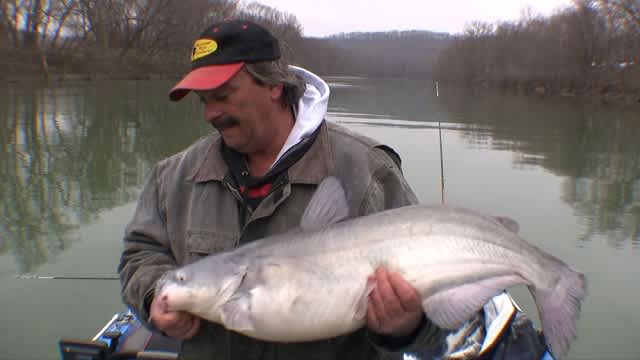Three Sure-Fire Places to Find Winter Blue Catfish
Steve Douglas 01.27.12

In the winter months, catfish will spend most of their time where the conditions are most favorable for them. Locations throughout the river or lake system that will provide some sort of thermal relief from the extreme temperatures are the key to finding trophy blue catfish. Another factor to finding huge catfish in the winter months is locating a food source or ideally, a location where they can find both comfort and a food source. Once you figure out where the cats’ preferred winter areas are in any given river or lake, you often can find fish in the same general areas day after day throughout the winter.
Catfish will frequent certain areas of water ways for one of three reasons.
- Food source: Locating schools of bait fish will help determine where you should fish for catfish. This could be in deep open water or a shallow point.
- Cover: Catfish are attracted to cover within the structure and deep water lairs. Wood log jams, boulders or manmade elements all attract bait fish and allow catfish to rest and wait for an ambush of unsuspecting prey.
- Navigation: Catfish will use underwater structure contours such as ledges, channels and ditches to navigate throughout a body of water. Think of these type of structures as underwater highways.
Seasonal patterns will often help determine locations as well. Winter is probably the most predictive time to locate catfish.
In rivers, the deep winter holes are often along outside bends or old river channels that run alongside a hard bottom bank. In reservoirs, look for the old creek and river channels. Channel confluences where the creek channel meets with the old river channel also tend to have deeper holes associated with them, run-ins or ditches will also provide some deep water habitat or hot spots.
Learning how to analyze the seasonal patterns, structure and cover to find the best winter time opportunity is the key to catching a winter trophy blue catfish. Here are three top hot spots to start looking for your trophy blue cats.
- Channel bends: A channel bend is just simply a turn in direction of the river flow and usually associated with hard bottom and deep water as the current flow is constantly cutting the structure contour of the bottom. This causes ledges and undercuts to form, giving these trophy blue catfish a comfortable environment to take up residence. Channel bends will also get cluttered with big trees and logs that get washed downriver and deposited over the years during high water periods, which gives the blue cats just one more reason to hang out. Now there’s a hot spot! Look for the cover that has lodged in the channel bends along the deep water ledges. Finding the “spot within the spot” is golden and will increase your chances of catching a trophy blue catfish.
- Holes: Holes are most often going to be associated with current of some kind. Look for holes around the channel bends, below dams, around the mouths of tributaries and current breaks such as points and manmade structure like barge cells or bridge pilings. Current breaks will create scour holes downriver of the break which is attractive to the big blue cats, as it makes an ideal spot to hang around and wait for food to flow by. Use your depth finder to locate the head of the hole and start there. Set up on these spots by anchoring above the holes and casting your baits back into the deeper water. Deep water holes of any structure type are always a good spot in the winter because catfish seem to stack into the deep water wintering holes, making them easier to locate.
- Mouths of tributaries: Tributary mouths are pretty much a year-round hot spot. They provide many elements throughout the catfish’s seasonal patterns, from staging to ambush and feeding areas. But in the winter months, the catfish will relate to the deep water at the mouth where it intersects the main river. Bait fish along with several other species of fish will gather in these deep water areas over winter and feed on what is washed out, in turn attracting the catfish to also take up residence for the duration.
There are many structural elements that that make up a tributary, giving the catfish some options in the winter months. Current breaks or ledges allow them sit and wait comfortably for food to pass by out of the current.
The deep holes associated with the tributaries provide a place to escape the current with some thermal comfort. The shallow points along the tributary will warm up on sunny days attracting the blue cats to the baitfish that have moved up on the point to the warmer water.
Check out this video for more guidance on locating winter time catfish:
For more tips on fishing for winter blues, click here to read my article on baits, rigs and methods.

